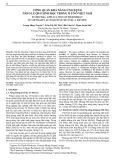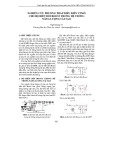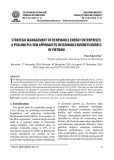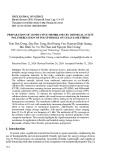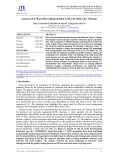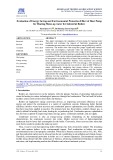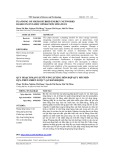
ISSN: 2615-9740
JOURNAL OF TECHNICAL EDUCATION SCIENCE
Ho Chi Minh City University of Technology and Education
Website: https://jte.edu.vn
Email: jte@hcmute.edu.vn
JTE, Volume 19, Issue 06, 2024
56
Evaluation of Energy Saving and Environmental Protection Effect of Heat Pump
for Heating Make-up water for Industrial Boilers
Kien Quoc Vo*, Thi Phuong Tuyen Nguyen
Ho Chi Minh City University of Technology (HCMUT), VNU-HCM, Ho Chi Minh City, Vietnam
*Corresponding author. Email: vkquoc@hcmut.edu.vn
ARTICLE INFO
ABSTRACT
Received:
23/10/2024
This paper investigates the integration of heat pumps for heating boiler
feedwater and evaluates the impacts of feedwater temperature and
condensate recovery rates on fuel consumption, energy efficiency, and CO2
emissions. The results show that using heat pumps significantly reduces
boiler fuel consumption, especially when the feedwater temperature
increases and the condensate recovery rate is high. In terms of energy, the
cost of heat pumps for water heating is significantly lower than that of fuel
combustion. With a boiler without condensate recovery, the maximum cost
of heat pumps is only about 50% of that of fuel combustion. Economically,
heat pumps provide substantial benefits, with maximum cost savings
achieved at a water temperature of 75°C. On average, a 10% reduction in
the condensate recovery rate, the cost saved in 1 hour is 2000 VND/ton of
steam. Additionally, integrating heat pumps reduces CO2 emissions,
particularly in boilers without condensate recovery, with the highest
emission reduction reaching 17.8 kgCO2/ton of steam. These findings
demonstrate that using heat pumps is not only energy-efficient and cost-
effective but also contributes to environmental protection by reducing
greenhouse gas emissions.
Revised:
04/11/2024
Accepted:
05/11/2024
Published:
28/12/2024
KEYWORDS
Heat pump;
Energy saving;
CO2 emissions;
Feed water;
Boiler;
COP.
Doi: https://doi.org/10.54644/jte.2024.1705
Copyright © JTE. This is an open access article distributed under the terms and conditions of the Creative Commons Attribution-NonCommercial 4.0
International License which permits unrestricted use, distribution, and reproduction in any medium for non-commercial purpose, provided the original work is
properly cited.
1. Introduction
Boilers are crucial devices in the industry, with the primary function of generating high-pressure
steam for heating in various technological processes through fuel combustion. The fuel used for boilers
includes sources derived from fossil fuels and biomass.
Boilers are high-power energy conversion devices, so improving conversion efficiency to save
energy and protect the environment is a matter of significant concern. Enhancing boiler thermal
efficiency involves waste heat recovery and combustion process optimization, two feasible solutions
that have long been applied in practice. The primary heat loss from boilers, emitted exhaust gas, is
widely utilized in heating feed water, heating air, or preheating fuel. Combustion process optimization
has also been explored by improving furnace design, grates, combustion methods, and air supply.
Condensate recovery is also an energy-saving solution. Depending on the technological
characteristics, the condensate recovery rate varies. Higher recovery rates of high-temperature
condensate lead to lower fuel consumption for the boiler. Conversely, lower recovery rates mean that
more fuel is needed to preheat the make-up water.
Thus, it can be seen that improving boiler efficiency has been extensively studied. The remaining
issue with modern boilers is the environmental impact. Fuel combustion in boilers can cause
environmental issues if not properly controlled. When fuel is burned, emissions such as CO₂, SO₂, NOx,
and fine particulate matter may be released into the air, contributing to air pollution and climate change.
Therefore, environmental protection in boiler use is of utmost importance. Environmental measures
include using cleaner fuels like natural gas or biomass, advancing combustion technology to minimize
emissions, and implementing modern dust filtration and exhaust treatment systems.







